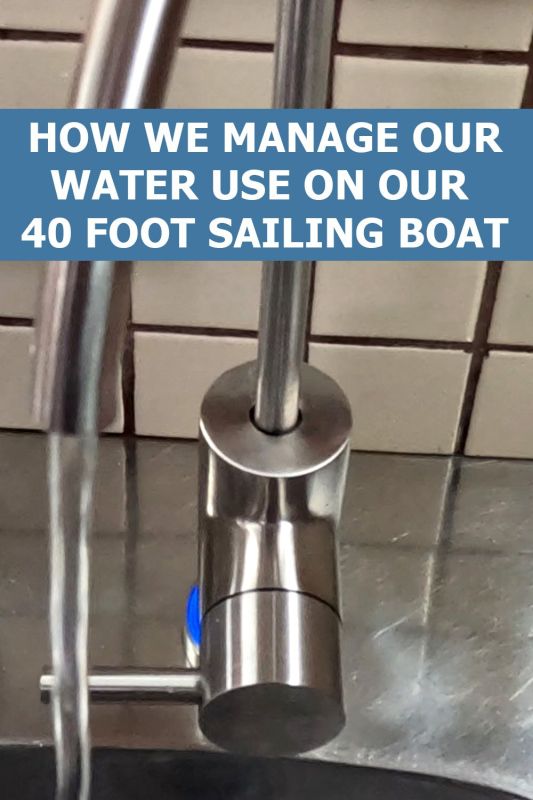
How we manage one of our most important resources onboard our sailboat: Water
February 26th, 2024
Learning to manage our water, power and food supply since living aboard our sailboat has been three of our biggest challenges. When we lived at home, it was so easy to just turn the tap on and get water. If we're in a marina, water supply is no issue. In some cases though, getting water might be more difficult if the source of the supply is not potable. When we live off grid for weeks at a time, we're not connected to town water supply so managing our water use becomes even more critical because, as we all know, we can't live without it. In our daily lives, there's not many tasks we do that don't involve water. We use water to wash ourselves and our clothes, water to clean including the dishes, water to drink, water to cook, and water to wash our hands. On land, water is even used to flush the toilet.
Tāiko has 2 x 200 liter water tanks situated under each saloon berth. Therefore, we can carry a total of 400 liters in our water tanks. Additional to this, we carry 2 x 20 liter water jerry cans which allow us to have a total of 440 liters of water aboard Tāiko. When we first moved aboard and tried off grid living for a couple of weeks, we attempted to monitor our water use but we were very relaxed about it at the same time. After all, this was all new to us and we were just getting used to living in a 40 foot boat as opposed to a 3 bedroom home. Also, we had been told that Tāiko's water tanks were 600 liters in total. However, we soon learned this was not the case.
It was whilst we were living off anchor for about 4 weeks in the Bay of Islands where we really learned our lesson about how important it was to properly manage our water use. We had just made it back to the mooring ball, made a cup of coffee (fortunately there was enough for a coffee because we really needed one), and when we turned the tap on again to the dishes, there was no water. Most boats may have a water maker onboard which means they can make potable water from salt water. But from the beginning, we had decided that we were going to keep Tāiko as a simple boat. The less we have, the less there is to fix, the less expensive it is, and the easier it is for us to independently maintain her systems. Choosing to keep Tāiko simple meant that we had no way of making water. We did however have a custom made water catcher made for Tāiko which fits under her boom and can catch water really well in heavy down pours. We've caught over 300 liters this way. But, you do need rain and heavy rain at that for it to work. Where we were on the mooring ball, the water supply was not potable. So, we had to buy water, which for us is unsustainable.
Running out of water taught us that we had to make some changes and get more serious about monitoring our water supply. Once back in the marina, we painstakingly filled a 1 liter measuring jug with water and marked in 5 liter increments the water jerry cans. We then used these jerry cans to fill 20 liters of water at a time into Tāiko's water tanks. With every 50 liters poured into her water tanks, we used a broom handle to measure the tanks water level in 50 liter increments. It turned out that Tāiko's tanks did not hold 600 liters as we were told but rather 400 liters. 200 liters less which is quite significant when living off grid.
Now, when we live off grid, we wash in salt water and rinse in fresh (we have a 5 liter spray bottle used for weeds to rinse us off which gives us maximum effect of rinsing from the spray with very little water use), when appropriate, we rinse our dishes in salt water and wash them in fresh, our drinking water is limited to a couple of liters a day, and we wash our clothes regularly so we don't use loads of water at a time. Our head doesn't use water so that's a bonus. We also now use our marked broom stick to monitor our water tank levels.
We have found that we consistently use an average of 10 liters of water a day for the both of us which isn't bad but there is room for improvement. Therefore, if we have 440 liters in total, this should last us 44 days which is good for us to know. Lastly, when it rains, we take advantage of catching the water whether we use it for filling up our tanks, filing up our jerry cans, filing up our spray bottle or laundry tub. We now no longer take rain for granted and make every effort to catch it when we have it. Recently we were out for 7 weeks, and we only had to pay to have our jerry cans filled up once during that time so not a bad effort. We've also recently installed an Acuva UV-LED water tap which when used, uses UV to disinfect the water coming through it providing us with an extra safety step should our water not be potable!